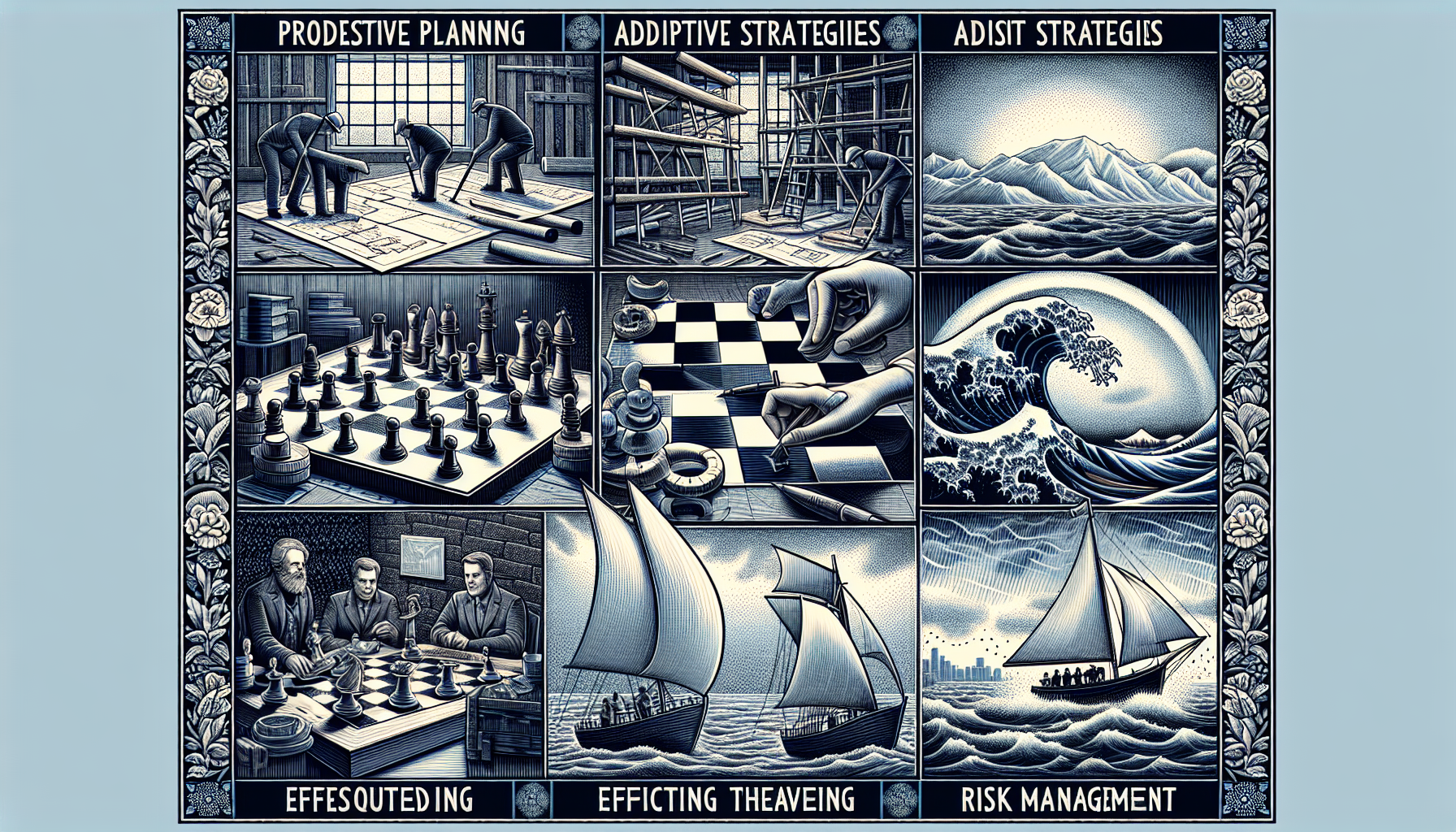A project manager plays a crucial role in risk management by identifying, analyzing, and addressing potential risks throughout the project lifecycle.
This involves proactive planning, continuous monitoring, and engaging with stakeholders to ensure all risks are managed effectively.
In this article, we will break down the key responsibilities of the risk management experts, the role of the project manager in risk management and how these responsibilities contribute to project success.
Key Takeaways
- Project managers play a strategic role in risk management, involving the continuous identification, analysis, and response to potential risks, ensuring project alignment with organizational risk appetite.
- Effective risk management requires integrating risk practices into every aspect of project planning, including the development of a documented risk management plan and fostering a positive risk culture within the team.
- Utilizing risk management tools and techniques, such as risk registers and project management software, along with continuous monitoring and stakeholder collaboration, is essential for systematic and efficient risk mitigation.
Understanding Risk Management in Projects

Risk management in projects prepares for the unexpected. It encompasses the identification, analysis, and response to potential risks that may influence project outcomes.
These risks, which can be threats or opportunities, require effective risk management strategies for the project to succeed. The risk management process is a structured approach to anticipating what might go wrong and having strategies in place to address those issues before they derail the project.
Effective risk management is more than just a safety net; it is a proactive approach that can prevent issues from arising, minimize their impact, and even capitalize on potential opportunities.
Project managers can lessen anxiety, boost predictability, and augment the likelihood of project success through systematic risk identification and management. This same approach to risk management also helps in maintaining credibility with stakeholders and ensures that projects stay on track in terms of schedule and cost.
The project risk manager*’s ultimate goal is to align risk management seamlessly with the project’s objectives and overall success. This involves practical steps to:
- Identify and track risks continuously throughout the project lifecycle.
- Analyze and prioritize risks.
- Develop responses to mitigate or address risks.
- Monitor risks to ensure that no critical details slip through the cracks.
By following these steps, the project manager can effectively take risk center manage risks and increase the chances of project success.
Embracing effective risk management practices enables project managers to retain a clear focus on the project’s objectives and construct a resilient framework capable of withstanding unexpected challenges. This not only ensures project success but also fosters a sense of stability and confidence within the project team.
Key Responsibilities of a Project Manager in Risk Management
Project managers play a strategic role in the risk management process, beginning from the project’s inception. They define how to manage business risks, ensuring that a documented risk management plan is in place from the outset.
This plan outlines specific risk approaches and sets the foundation for how risks will be identified, analyzed, and responded to throughout the project. In this context, project managers take on crucial risk management roles.
Their primary duties as project managers include:
- Leading and managing the project
- Integrating risk management into every aspect of project planning and execution
- Ensuring alignment of project objectives with the organization’s risk appetite
- Fostering a positive risk cultureFostering a positive risk culture
- Promoting effective risk management practices
- Overseeing the entire risk management process
- Ensuring compliance with relevant standards and regulations
- Coordinating with stakeholders to identify and assess risks.
A critical responsibility of project managers is to be risk owner and ensure that risks are:
- Identified
- Tracked
- Monitored
- Assessed continuously
Project managers escalate operational risks to relevant teams and flag serious risks to the enterprise risk management team. Their role managing risk, also includes validating costs associated with identified risks, which can vary depending on the project’s scale and complexity.
Collaboration with the risk manager is vital. Project managers should:
- Establish expectations and validate proposals from risk managers
- Maintain a global vision of risks and opportunities
- Effectively manage critical risk response strategies proposed by risk owners
- Ensure that the project remains on course despite potential challenges
This strategic positioning helps project managers to effectively manage risks and ensure project success.
Integrating Risk Management into Project Planning
Proactive planning for project risks during the project planning phase can steer a project team into calm waters, preventing unexpected issues. Early consideration of potential risks allows project managers to devise mitigation strategies to tackle these risks before they escalate.
This proactive approach to opportunity management is essential for ensuring that the project remains on track and achieves its objectives.
Creating a risk management plan during the planning phase helps in identifying potential risks and their impact early on. This plan details how the team will identify, analyze, and respond to any potential threats and project risks that haven’t occurred yet.
It’s not just about reacting to risks as they arise, but about having a structured approach to monitor and address potential issues before they occur.
Integrating risk management into project planning equips project managers to be prepared for any eventuality. This not only helps in mitigating risks but also in capitalizing on opportunities that may arise during the project.
It sets a solid foundation for effective risk management practices throughout the project lifecycle.
Identifying and Assessing Project Risks

The identification and assessment of project risks is a crucial step in the risk management process. Project managers must collaborate with stakeholders and team members to identify risks by:
- Identify and document potential risks
- Log them in a risk register
- Initiate risk identification early in the project to capture top risks during high uncertainty phases.
Various techniques can be employed to identify risks, such as brainstorming sessions, interviews with project managers role key stakeholders, and SWOT analysis.
Brainstorming sessions focused on specific project objectives or tasks can reveal associated risks. Including stakeholders in these sessions not only brings new insights but also increases their investment in the project’s success.
Once risks are identified, they need to be analyzed to determine which require subsequent management. This involves both qualitative and quantitative risk analysis methods.
Tools such as root cause analysis and assumption analysis can help in understanding the fundamental risks and their implications.
Evaluating the accuracy and reliability of quantitative risk analysis data helps project managers maintain a clear understanding of the project’s risk landscape.
Developing and Implementing Risk Mitigation Plans

The development and implementation of risk mitigation plans is a key responsibility of project managers. These risk response plans involve developing options and actions to enhance opportunities and reduce threats to project objectives. Risk mitigation includes reducing exposure to risks and minimizing the likelihood of issues arising during the project.
A comprehensive risk mitigation plan should include risk responses, risk owners, and the resources needed to carry out the plan. It’s essential to have a plan in place to deal with the ongoing crisis, including monitoring, controlling, and managing resources effectively.
Having these plans ready enables project managers to ensure effective risk management, thereby contributing to the overall success of the project.
Continuous Monitoring and Reporting of Risks
The continuous monitoring and reporting of risks is essential for effective risk management. Regular risk assessments, such as weekly reviews, ensure ongoing identification and management of risks.
Setting up key performance indicators (KPIs) and early warning signals is crucial for proactive risk assessment and monitoring.
Implementing robust monitoring and control mechanisms aids in tracking identified risks and evaluating the effectiveness of mitigation measures.
Regular communication of project risks helps in maintaining alignment with project goals and obtaining support from upper management. Continuously updating and reviewing the risk register enables project managers to stay informed about current risk exposure and make necessary adjustments.
Collaborating with Team Members and Stakeholders
Collaboration with team members and project stakeholders is a crucial aspect of successful risk management. Building strong partnerships with stakeholders allows for the exchange of ideas and feedback, ensuring projects meet expectations.
Effective communication and collaboration with stakeholders like contractors and suppliers are essential for managing risks effectively in projects.
Assigning risk owners early on ensures that team members are prepared to monitor and respond to potential risks. By fostering an environment of open communication, project managers can ensure that team members feel comfortable expressing their ideas and concerns, promoting a proactive risk culture within the project team.
Utilizing Risk Management Tools and Techniques

The utilization of risk management tools and techniques, also known as risk management or critical risk response strategies, is crucial for effective risk management. Some of these tools include:
- Risk registers: a comprehensive document that tracks potential risks throughout a project’s lifecycle, helping to organize and monitor identified risks and their mitigation plans.
- Risk matrices: a visual tool that helps in analyzing and prioritizing risks based on their likelihood and impact.
- Project management software: software that helps in identifying, analyzing, prioritizing, and responding to risks.
These tools are essential for identifying, analyzing, prioritizing, and responding to risks systematically and efficiently.
Project management software like ProjectManager integrates risk management tools with features such as Gantt charts, kanban boards, and project dashboards. These tools facilitate the risk management process and foster a collaborative environment, ensuring that risks are effectively managed throughout the project lifecycle.
Enhancing Risk Culture within the Project Team
The enhancement of risk culture within the project team is vital for successful risk management. Project managers play a key role in fostering a risk-aware culture by:
- Leading by example
- Creating a safe environment within the team
- Promoting open communication
- Ensuring that team members feel comfortable expressing their ideas and concerns
These actions are essential for a proactive risk culture.
Empowering team members to identify and address risks proactively helps instill a mindset of transparency and accountability.
A culture of continuous improvement and learning within the project team enhances the effectiveness of risk monitoring and contributes to overall project success.
The Role of Project Managers in Financial Risk Management
For project managers, financial literacy is key to:
- Assessing financial risks
- Managing project budgets effectively
- Understanding the financial implications of decisions
- Optimizing project success
- Ensuring that projects remain within budget
- Making informed decisions
- Developing strategies to mitigate financial risks
Project managers must have basic finance skills to achieve these goals.
Project managers bear the responsibility of developing accurate project budgets, monitoring expenditures, and tracking expenses in real-time to spot any variances.
By balancing risk and reward, project managers can maximize project potential while minimizing financial uncertainties. Analyzing financial trends helps in identifying potential financial risks and optimizing project performance.
Case Studies: Successful Risk Management by Project Managers

Real-world examples underscore the importance of proactive planning, flexible strategies, and effective risk management practices.
In a manufacturing facility project, project managers mitigated risks related to labor shortages by implementing strategic workforce planning and offering competitive wages. To address potential weather disruptions, contingency plans included alternative work schedules and sourcing materials from different suppliers.
These examples highlight how proactive planning and flexible strategies are crucial for successful risk management in projects. Understanding how project managers have successfully managed risks in real-world scenarios helps illustrate effective risk management practices and reinforces the importance of being prepared for any eventuality.
Summary
In conclusion, effective risk management is the cornerstone of successful project management. Project managers play a strategic role in identifying, assessing, and mitigating risks to ensure project success.
By integrating risk management into project planning, collaborating with stakeholders, utilizing risk management tools, and fostering a risk-aware culture, project managers can navigate through uncertainties and achieve project objectives.
Embracing these practices not only helps senior management in managing risks but also in capitalizing on opportunities that may arise during the project. By continuously improving risk management practices, project managers can build resilient teams and ensure the successful completion of their projects. Let’s take these insights and apply them to our projects to achieve greater success.
Frequently Asked Questions
What is the role of a project manager in risk management?
The role of a project manager in risk management is to identify, assess, and mitigate risks throughout the project lifecycle, develop risk management plans, collaborate with stakeholders, and ensure compliance with relevant standards and regulations.
How can project managers integrate risk management into project planning?
Project managers can integrate risk management into project planning by proactively identifying and mitigating potential risks through a well-defined risk management plan. This ensures that risks are addressed early in the project timeline.
What tools and techniques can project managers use for risk management?
Project managers can use risk registers, the risk matrix matrices, and project management software to effectively identify, analyze, prioritize, and respond to risks throughout the project lifecycle. These tools are crucial for comprehensive risk management.
How can project managers foster a risk-aware culture within their team?
Project managers can foster a risk-aware culture by leading by example, promoting open communication, and empowering team members to proactively identify and address risks. It is essential to create a safe environment where team members feel comfortable expressing their ideas and concerns.
What is the importance of financial literacy for project managers in risk management?
Financial literacy is important for project managers in risk management as it helps them assess financial risks, develop mitigation strategies, and manage project budgets effectively, ultimately optimizing project success and staying within budget.

Chris Ekai is a Risk Management expert with over 10 years of experience in the field. He has a Master’s(MSc) degree in Risk Management from University of Portsmouth and is a CPA and Finance professional. He currently works as a Content Manager at Risk Publishing, writing about Enterprise Risk Management, Business Continuity Management and Project Management.

